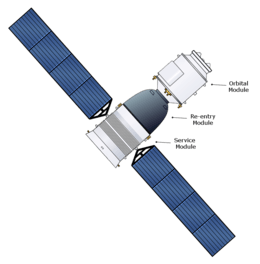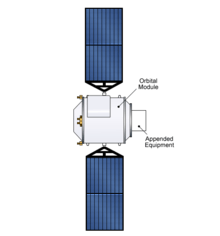Shenzhou (spacecraft)
Shenzhou (/ˈʃɛnˈdʒoʊ/;[1] Chinese: 神舟; pinyin: Shénzhōu) is a spacecraft developed and operated by China using Soyuz technology to support its crewed spaceflight program. The name is variously translated as Divine vessel,[2] Divine craft,[3] or Divine ship.[4] Its design resembles the Russian Soyuz spacecraft, but it is larger in size. The first launch was on 19 November 1999 and the first crewed launch was on 15 October 2003. In March 2005, an asteroid was named 8256 Shenzhou in honour of the spacecraft.
 Diagram of the post-Shenzhou 7 spacecraft | |
| Country of origin | China |
|---|---|
| Operator | CNSA |
| Applications | Crewed spaceflight |
| Specifications | |
| Design life | 20 days |
| Launch mass | 7840 kg |
| Dimensions | 9.25 x 2.8 m |
| Volume | 14.00 m3 |
| Regime | Low Earth |
| Dimensions | |
| Production | |
| Status | In service |
| Built | 11 |
| Launched | 11 |
| Operational | 0 |
| Retired | 11 |
| Failed | 0 |
| Maiden launch | Shenzhou 1, 1999 |
| Last launch | Shenzhou 11, 2016 |
| Related spacecraft | |
| Derived from | Soyuz |
| Shenzhou | |||||||||||
|---|---|---|---|---|---|---|---|---|---|---|---|
| Chinese | 神舟 | ||||||||||
| Simplified Chinese | 神舟 | ||||||||||
| Literal meaning | Divine Vessel/Craft | ||||||||||
| |||||||||||
History
China's first efforts at human spaceflight started in 1968 with a projected launch date of 1973.[5] Although China successfully launched an uncrewed satellite in 1970, its crewed spacecraft program was cancelled in 1980 due to a lack of funds.[6]
The Chinese crewed spacecraft program was relaunched in 1992 with Project 921. The Phase One spacecraft followed the general layout of the Russian Soyuz spacecraft, with three modules that could separate for reentry. China signed a deal with Russia in 1995 for the transfer of Soyuz technology, including life support and docking systems. The Phase One spacecraft was then modified with the new Russian technology.[6] The general designer of Shenzhou-1 through Shenzhou-5 was Qi Faren (戚发轫, 26 April 1933), and from Shenzhou-6 on, the general design was turned over to Zhang Bainan (张柏楠, 23 June 1962).
The first uncrewed flight of the spacecraft was launched on 19 November 1999, after which Project 921/1 was renamed Shenzhou, a name reportedly chosen by Jiang Zemin. A series of three additional uncrewed flights were carried out. The first crewed launch took place on 15 October 2003 with the Shenzhou 5 mission. The spacecraft has since become the mainstay of the Chinese crewed space program, being used for both crewed and uncrewed missions.
Design
Shenzhou consists of three modules: a forward orbital module (轨道舱), a reentry module (返回舱) in the middle, and an aft service module (推进舱). This division is based on the principle of minimizing the amount of material to be returned to Earth. Anything placed in the orbital or service modules does not require heat shielding, increasing the space available in the spacecraft without increasing weight as much as it would if those modules were also able to withstand reentry.
- Complete spacecraft data
- Total mass: 7840 kg
- Length: 9.25 m
- Diameter: 2.80 m
- Span: 17.00 m
Orbital module

The orbital module (轨道舱) contains space for experiments, crew-serviced or crew-operated equipment, and in-orbit habitation. Without docking systems, Shenzhou 1–6 carried different kinds of payload on the top of their orbital modules for scientific experiments.
Up until Shenzhou 8, the orbital module of the Shenzhou was equipped with its own propulsion, solar power, and control systems, allowing autonomous flight. It is possible for Shenzhou to leave an orbital module in orbit for redocking with a later spacecraft, a capability which Soyuz does not possess, since the only hatch between the orbital and reentry modules is a part of the reentry module, and orbital module is depressurized after separation. For future missions, the orbital module(s) could also be left behind on the planned Chinese project 921/2 space station as additional station modules.
In the uncrewed test flights launched, the orbital module of each Shenzhou was left functioning on orbit for several days after the reentry modules return, and the Shenzhou 5 orbital module continued to operate for six months after launch.
- Orbital module data
- Design life: 200 days
- Length: 2.80 m (9.10 ft)
- Basic diameter: 2.25 m (7.38 ft)
- Maximum diameter: 2.25 m (7.38 ft)
- Span: 10.40 m (34.10 ft)
- Habitable volume: 8.00 m³
- Mass: 1500 kg (3,300 lb)
- RCS Coarse No x Thrust: 16 x 5 N
- RCS Propellants: Hydrazine
- Electrical system: Solar panels, 12.24 m²
- Electric system: 0.50 average kW
- Electric system: 1.20 kW
Reentry module
The reentry module (返回舱) is located in the middle section of the spacecraft and contains seating for the crew. It is the only portion of Shenzhou which returns to Earth's surface. Its shape is a compromise between maximizing living space and allowing for some aerodynamic control upon reentry.
- Reentry module data
- Crew size: 3
- Design life: 20 days
- Length: 2.50 m (8.20 ft)
- Basic diameter: 2.52 m (8.26 ft)
- Maximum diameter: 2.52 m (8.26 ft)
- Habitable volume: 6.00 m³
- Mass: 3240 kg (7,140 lb)
- Heat shield mass: 450 kg (990 lb)
- Lift-to-drag-ratio (hypersonic): 0.30
- RCS Coarse No x Thrust: 8 x 150 N
- RCS Propellants: Hydrazine
Service module
The aft service module (推进舱) contains life support and other equipment required for the functioning of Shenzhou. Two pairs of solar panels, one pair on the service module and the other pair on the orbital module, have a total area of over 40 m2 (430 ft²), indicating average electrical power over 1.5 kW (Soyuz have 1.0 kW).
- Service module data
- Design life: 20 days
- Length: 2.94 m (9.65 ft)
- Basic diameter: 2.50 m (8.20 ft)
- Maximum diameter: 2.80 m (9.10 ft)
- Span: 17.00 m (55.00 ft)
- Mass: 3000 kg (6,600 lb)
- RCS Coarse No x Thrust: 8 x 150 N
- RCS Fine No x Thrust: 16 x 5 N
- RCS Propellants: N2O4 / MMH, unified system with main engine
- Main engine: 4 x 2500 N
- Main engine thrust: 10.000 kN (2,248 lbf)
- Main engine propellants: N2O4 / MMH
- Main engine propellants: 1000 kg (2,200 lb)
- Main engine Isp: 290 seconds
- Electrical system: Solar panels, 24.48 + 12.24 m², 36.72 m² total
- Electric system: 1.50 average kW
- Electric system: 2.40 kW
Comparison with Soyuz
Although the Shenzhou spacecraft follows the same layout as the Russian Soyuz spacecraft, it is substantially larger than Soyuz. There is enough room to carry an inflatable raft in case of a water landing, whereas Soyuz astronauts must jump into the water and swim. The commander sits in the center seat on both spacecraft. However, the copilot sits in the left seat on Shenzhou and the right seat on Soyuz.[7]
In popular culture
- The Shenzhou was prominently featured in the film Gravity and was used by the main character, STS-157 Mission Specialist Dr. Ryan Stone, to safely return home after the destruction of her spacecraft.[8][9]
- In Star Trek: Discovery, the Walker class starship USS Shenzhou is named after this spacecraft.[10]
See also
- 863 Program
- Beihang University
- China National Space Administration
- Chinese next-generation crewed spacecraft
- Chinese space program
- Harbin Institute of Technology
- Long March (rocket family)
- Names of China
- Shuguang
- Soyuz (spacecraft)
- Spacecraft
- Tiangong program
References
- "Shenzhou pronunciation". Dictionary.com. Retrieved 25 April 2015.
- "Expedition 7 Crew Members Welcome China to Space". NASA. 17 October 2003. Retrieved 17 August 2018.

- Scuka, Daniel (26 March 2018). "Tiangong-1 frequently asked questions". ESA. Retrieved 17 August 2018.

- "China's Shenzhou spacecraft – the "divine ship"". New Scientist. 12 October 2005. Retrieved 17 August 2018.
- Mark Wade (2009). "Shuguang 1". Encyclopedia Astronautica. Archived from the original on 14 July 2007. Retrieved 4 March 2009.
- Futron Corp. (2003). "China and the Second Space Age" (PDF). Futron Corporation. Archived from the original (PDF) on 19 April 2012. Retrieved 6 October 2011.
- Hollingham, Richard (27 June 2018). "Why Europe's astronauts are learning Chinese". BBC Future.
- Kramer, Miriam (6 October 2013). "The Spaceships of 'Gravity': A Spacecraft Movie Guide for Astronauts". yahoo.com. Yahoo. Retrieved 23 April 2017.
- Lyons, Lauren (19 October 2003). ""Gravity", China and the end of American Exceptionalism in outer space". spaceflightinsider.com. Spaceflight Insider. Retrieved 23 April 2017.
- Kramer, Miriam (25 July 2020). "The Spaceships of 'Gravity': A Spacecraft Movie Guide for Astronauts". startrek.com. CBS Entertainment. Retrieved 25 July 2020.
Further reading
| Wikimedia Commons has media related to Shenzhou. |
- "Shenzhou". Archived from the original on 13 October 2005. Retrieved 21 July 2005.
- "China's first astronaut revealed". BBC. 7 March 2003.
- "Brief history of Russian aid to Chinese space program". Archived from the original on 8 April 2007. Retrieved 7 June 2007.
- "Details on purchase of Soyuz descent capsule by China, Space.com". Archived from the original on 2 June 2008. Retrieved 7 June 2007.
External links
- Flickr: Photos tagged with shenzhou, photos likely relating to Shenzhou spacecraft
- Subsystems and Project management of Shenzhou 7
